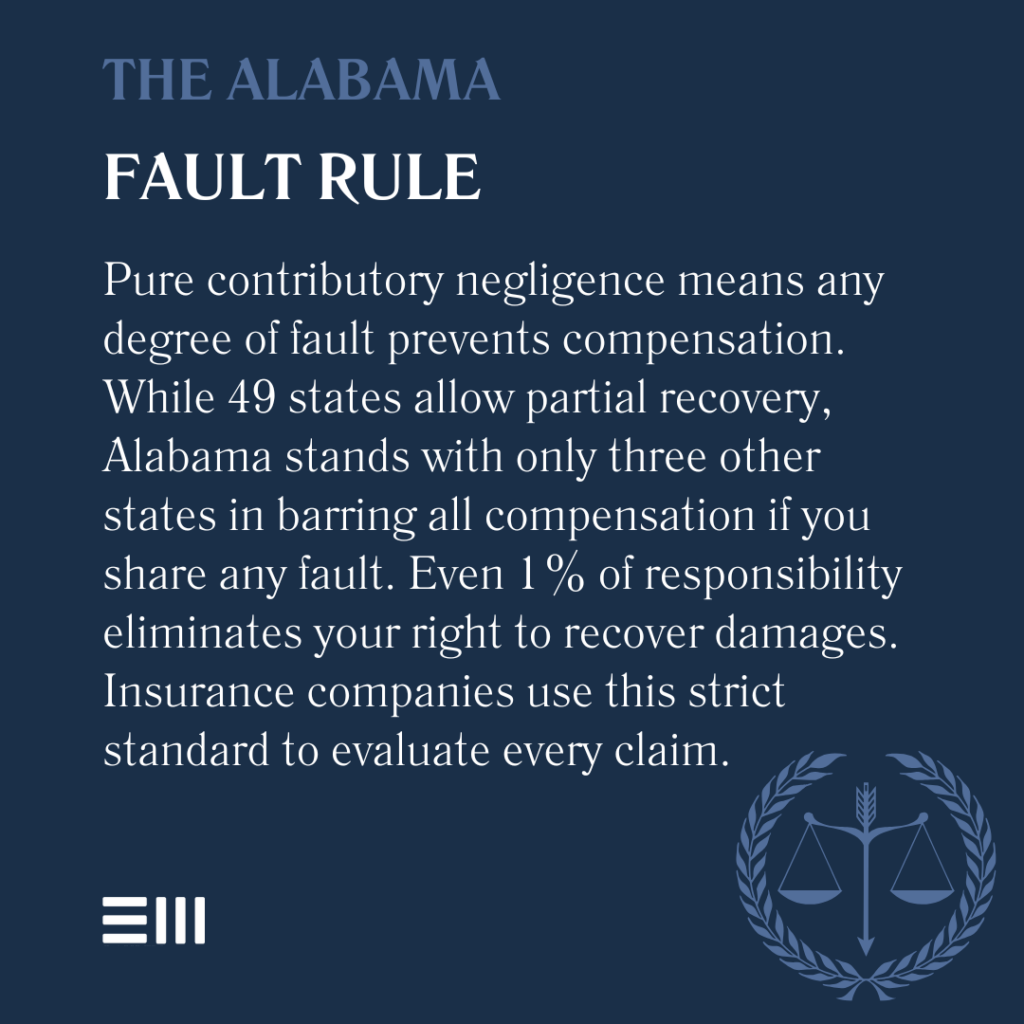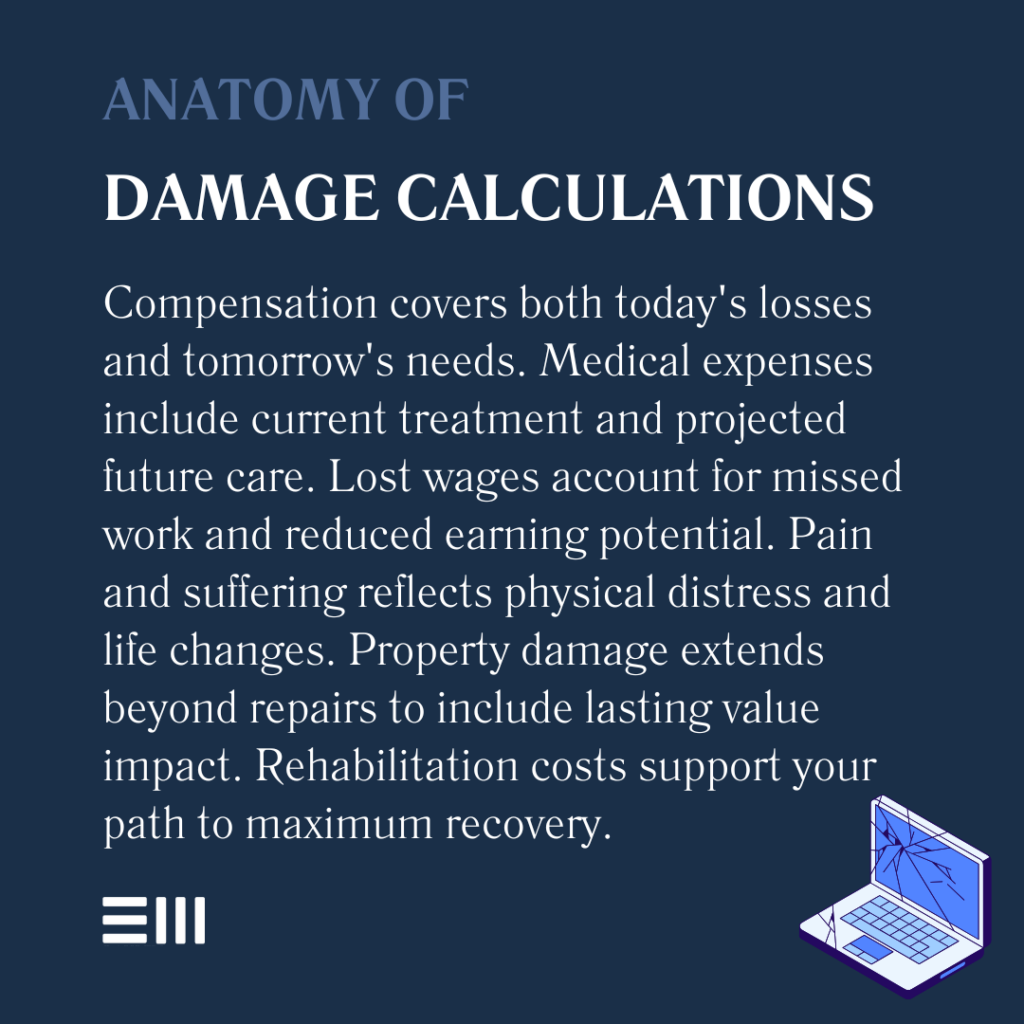
Picture this: A distracted driver runs a red light while you’re checking a text message at an intersection.
In most states, you’d still receive partial compensation for your injuries. But in Alabama, that momentary glance at your phone could cost you everything.
As one of only four states practicing pure contributory negligence, Alabama’s approach to shared fault dramatically shapes the outcome of personal injury cases.
The difference between full compensation and walking away empty-handed often hinges on understanding these unique rules—and knowing how to protect your rights from the moment an accident occurs.
Understanding Negligence in Alabama
Alabama stands apart from most states with its unique approach to shared fault in accidents and injuries.
The state’s adherence to the contributory negligence doctrine creates a complex legal landscape that requires careful navigation to protect your rights.
Understanding these fundamental principles before taking any legal action can help you avoid common pitfalls that could jeopardize your case.
- Alabama follows the contributory negligence doctrine, making it one of only four states with this strict approach. This system can completely bar recovery even if you were only minimally at fault for your injuries.
- Under this system, being even 1% at fault can prevent you from recovering any damages. This makes it crucial to document all aspects of your accident thoroughly and avoid making statements that could be interpreted as admitting fault.
- Courts examine detailed evidence, including expert testimony, witness statements, and physical evidence from the accident scene, to determine fault percentages in each case. The interpretation of this evidence can make the difference between full compensation and no recovery at all.
- Insurance companies often use this strict standard during settlement negotiations to minimize or deny claims. They may attempt to find even minor evidence of contributory negligence to avoid paying compensation.
- Different types of evidence, including surveillance footage, accident reconstruction reports, and expert analysis of the accident scene, can help establish or defend against claims of shared fault.
Understanding these principles helps protect your rights and positions you for the strongest possible case outcome. Many accident victims unknowingly compromise their cases by failing to appreciate the significance of Alabama’s contributory negligence rules.

How Damages Are Calculated Under Comparative Negligence
The calculation of damages involves multiple factors that must be carefully documented and presented.
Insurance companies and courts look at both economic and non-economic damages when determining compensation amounts.
Understanding these categories helps ensure you account for all potential damages in your claim.
- Medical expenses, both current and projected future costs;
- Lost wages and diminished earning capacity;
- Property damage and replacement costs;
- Pain and suffering compensation; and
- Rehabilitation and ongoing care expenses.
These elements form the foundation of your damage claim, but proper documentation is crucial for maximum recovery. Working with experienced professionals helps ensure all potential damages are identified and properly valued.

Evidence Requirements for Proving Fault
Building a strong case requires specific types of evidence that can clearly establish liability and counterclaims of shared fault.
The quality and completeness of your evidence often determine the strength of your legal position. Understanding what evidence to gather and preserve can significantly impact your case outcome.
- Accident scene photographs and videos should capture multiple angles and perspectives. Document road conditions, weather, signage, and any relevant markings or debris. These visual records often prove invaluable in reconstructing the accident sequence.
- Witness statements and contact information need to be gathered promptly while memories are fresh. Independent witnesses can provide crucial, unbiased testimony about how the accident occurred and who appeared to be at fault.
- Police reports and official documentation provide an objective third-party account of the accident. These reports often include crucial details about road conditions, weather, and initial statements from all parties involved.
- Medical records and expert testimonies establish the connection between the accident and your injuries. They also help document the full extent of your damages and future medical needs. Detailed medical documentation supports both your injury claims and damage calculations.
- Surveillance footage from nearby businesses or traffic cameras can provide indisputable evidence of how an accident occurred. Acting quickly to preserve this evidence is essential, as many systems automatically delete footage after a short period.
Proper evidence collection and preservation significantly strengthen your position in negotiations and court proceedings. Early action to secure evidence often proves crucial to case outcomes, especially in complex liability situations.
Time Limitations and Legal Deadlines
Alabama’s statute of limitations creates strict deadlines for filing your claim. Understanding and complying with these deadlines is essential for preserving your legal rights. Different types of claims may have varying deadlines and notice requirements.
- Two-year statute of limitations for most personal injury cases;
- Different deadlines for claims against government entities;
- Specific requirements for preserving evidence;
- Notice requirements for certain types of claims; and
- Exceptions that might extend filing deadlines.
Missing these deadlines can permanently bar your right to compensation, making timely action essential. Consulting with legal professionals early helps ensure compliance with all applicable deadlines.
Common Questions About Comparative Negligence
Navigating the complexities of Alabama’s contributory negligence system raises many questions for accident victims.
Understanding these common concerns can help you better protect your legal rights and make informed decisions about your case.
What Happens if I am Partially at Fault for an Accident?
Under Alabama’s contributory negligence rule, any degree of fault can prevent recovery of damages. This makes it crucial to have skilled legal representation to defend against claims of shared fault. Your attorney can help gather evidence to demonstrate that the other party bore full responsibility for the accident.
How Does the Court Determine Fault Percentages?
Courts examine all available evidence, including witness testimony, expert analysis, and physical evidence, to determine how each party’s actions contributed to the accident. This process often involves detailed accident reconstruction and expert testimony to establish the sequence of events and each party’s role in causing the accident.
Can I Still Recover Damages if the Other Party Claims I Was at Fault?
Yes, but you’ll need to prove that you bore no responsibility for the accident. This often requires detailed evidence and expert testimony to counter their claims. Early preparation and thorough documentation significantly improve your chances of success.
What Evidence Do I Need to Prove the Other Party Was at Fault?
Strong cases typically include photographs, witness statements, expert testimony, medical records, and any available video footage of the incident. The more comprehensive your evidence collection, the stronger your position in negotiations and court proceedings.
How Long Do I Have to File a Lawsuit in Alabama?
Generally, you have two years from the date of the accident to file a lawsuit, but certain circumstances may shorten or extend this deadline. Consulting with an attorney early helps ensure compliance with all applicable deadlines.
Protect Your Right to Full Compensation
Don’t let questions about comparative negligence prevent you from seeking the compensation you deserve. Our experienced legal team understands Alabama’s complex fault laws and can help protect your rights. We have successfully handled numerous cases involving disputed liability and complex damage calculations.
Contact Baxley Maniscalco today for a free consultation. We’ll evaluate your case, explain your options, and fight for the full compensation you deserve.
Our experienced team knows how to navigate Alabama’s strict contributory negligence rules to protect your interests.
Can't find what you're looking for? Search our site below.










